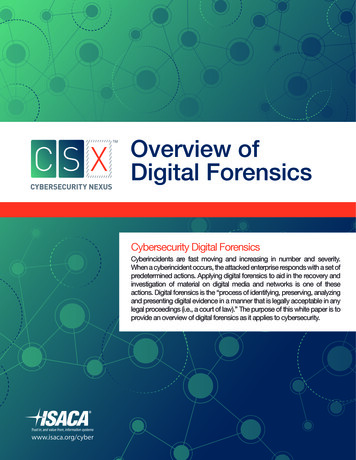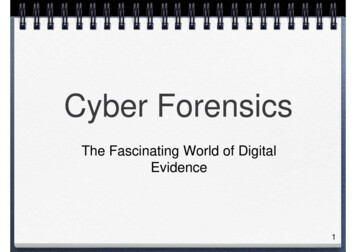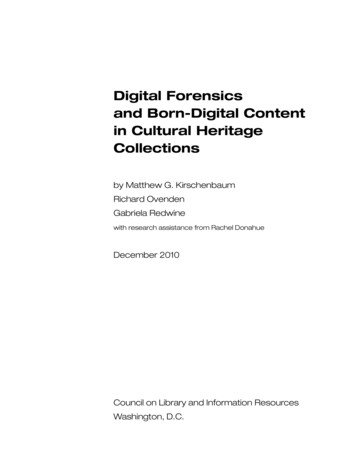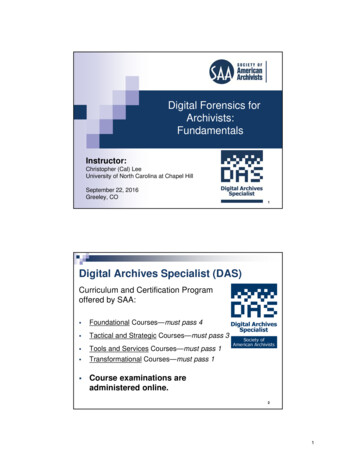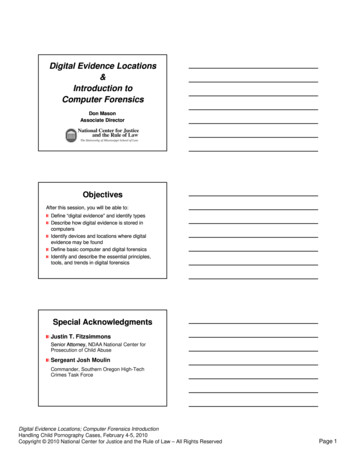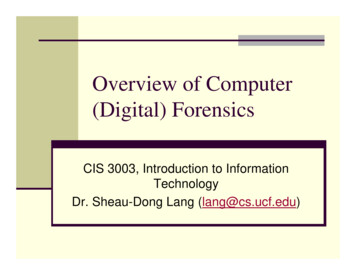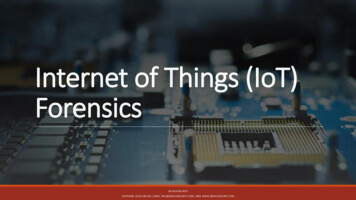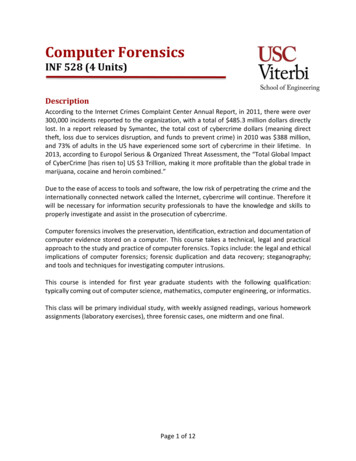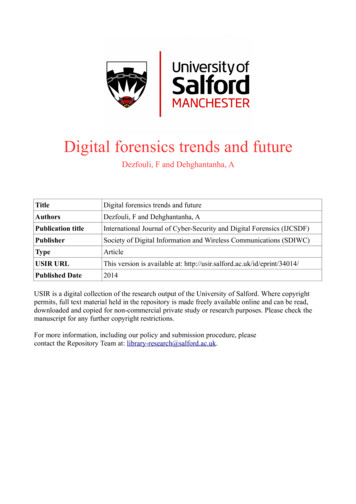
Transcription
Digital forensics trends and futureDezfouli, F and Dehghantanha, ATitleDigital forensics trends and futureAuthorsDezfouli, F and Dehghantanha, APublication titleInternational Journal of Cyber-Security and Digital Forensics (IJCSDF)PublisherSociety of Digital Information and Wireless Communications (SDIWC)TypeArticleUSIR URLThis version is available at: d Date2014USIR is a digital collection of the research output of the University of Salford. Where copyrightpermits, full text material held in the repository is made freely available online and can be read,downloaded and copied for non-commercial private study or research purposes. Please check themanuscript for any further copyright restrictions.For more information, including our policy and submission procedure, pleasecontact the Repository Team at: library-research@salford.ac.uk.
International Journal of Cyber-Security and Digital Forensics (IJCSDF) 2(2): 48-76The Society of Digital Information and Wireless Communications, 2013 (ISSN: 2305-0012)Digital Forensic Trends and FutureFarhood Norouzizadeh Dezfoli, Ali Dehghantanha, Ramlan Mahmoud, Nor Fazlida BintiMohd Sani, Farid DaryabarFaculty of Computer Science and Information TechnologyUniversity Putra Malaysia{Farhood1990, farid0fx} @gmail.com{alid, ramlan, fazlida} @fsktm.upm.edu.myABSTRACTNowadays, rapid evolution of computersand mobile phones has caused thesedevices to be used in criminal activities.Providing appropriate and sufficientsecurity measures is a difficult job due tocomplexity of devices which makesinvestigating crimes involving thesedevices even harder. Digital forensic isthe procedure of investigating computercrimes in the cyber world. Manyresearches have been done in this area tohelp forensic investigation to resolveexisting challenges. This paper attemptsto look into trends of applications ofdigital forensics and security at hand invarious aspects and provide someestimations about future research trendsin this area.KEYWORDSDigital forensics, Image, ion, Intrusion, Validation.1 INTRODUCTIONDigital forensics process involvescollection, preservation, analysis andpresentation of evidence from digitalsources. With the rise of challenges inthe field of forensic investigations,problems that are more interesting arelooming on the horizon for both victimsand investigators. As computers becomesmaller, faster and cheaper, computersare increasingly being embedded insideother larger systems which allowinformation to be created, stored,processed, analyzed and communicatedin ways that are unpredicted. Once wegathereddigitalevidencefrommonolithic, stand-alone mainframeswhereastoday wehavePCs,supercomputers, distributed client-servernetworks, laptops and smart phones, andLANs and WANs to convey informationacross the world, each of which is apotential source of digital evidence.Evidences stored in a computer is notunique with regard to relevancy andmateriality, but because it can be easilyduplicated and modified, often withoutleaving any traces and is readilyavailable to a miscreant using anothercomputer half a world away and hence,should be constrained by evolving legalstandards and constraints to defendprivacy issues.In general, privacy means allowing ordisallowing access to information. Thecode of ethics requires the forensicsprofessionals to maintain the privacy ofthe client. In the event of properinvestigation of cases, depending on thesensitivity of the issue and therequirement of the result, the privacy ofthe client may need to be compromised.48
International Journal of Cyber-Security and Digital Forensics (IJCSDF) 2(2): 48-76The Society of Digital Information and Wireless Communications, 2013 (ISSN: 2305-0012)But it is also possible the victimorganization might lose out the trust overforensics team. Moreover there areorganizations where in any slightleakage of the issue may attract hugemedia attention resulting in endangeringthe reputation and finally the business oforganization.In such situations, privacyrights and law enforcement’s need tosearch and seize digital evidence duringdigital forensic belong together.It mayalso be possible that the forensics expertmay not share the information with anythird party but takes the advantage of theconfidential information of the clienthimself, which is also a case of violationof right to privacy. That is why, it is thepolicy maker’s responsibility to see theimpact of forensics in the broadercontext of business goals and make thehard decisions that trade off forensicscapabilities with issues of privacy and,correspondingly, morale.Key strategies for digital forensics inorder to protect privacy are selectiverevelation, strong audit and ruleprocessing technologies. In the presentsituation, the dilemmas are How tomonitor digital forensics while keepingsearch information secret? How do wekeep private information from beingimproperly disclosed in the name offorensics?This paper comprises of 3 Sections andwill be presented as such: Section 2narrate the data collection procedure forthis review as well as the limitations ofthe collected data. Section 3 discusses allthe collected papers and analyses theresult of each paper. Finally, section 4concludes the paper and summarizes theoverall development of technology indigital forensic.2 CURRENT TRENDS IN DIGITALFORENSICThis section identifies the limitation ofthis work and explains the procedure ofdata collection.2.1 Limitations of the StudyIt is unlikely that this approach willcapture the true picture of privacyprotection in current digital forensiclandscape, as they are delicate in eachresearch specimen. The papers read aremore interested to discuss exploitingsecurity mechanism and frameworkratherthanprivacyprotectiontechniques. The numbers of papersprovided are also too few to adequatelysustain very significant research value.Most of the papers reviewed are toospecific in their corresponding researchfield and purpose; it is difficult togeneralize the specimen into statisticaldata with higher accuracy. The researchnature and scenarios used cannot be fullydepended upon as they are notnecessarily applicable in another similarscenario. Since the publications gothrough a lengthy peer review processthat adds a long time lag to thepublication route, they are not soresponsive to the current security trendsand issues. Hence, they tend to be afollowing rather than a leading indicatorof information security trends. We alsorealize that almost all specimens arefrom the Elsevier journal platform, andthus there is a limitation on theavailability of more related researchpublications in other sources. We alsoidentified another limitation, which isthe lack of graphical statistical data, asmost of the papers researched do notnecessarily belong to statistically basedresearch. It is not practical to addstatistical assumptions depending on thegiven articles only rather it has the49
International Journal of Cyber-Security and Digital Forensics (IJCSDF) 2(2): 48-76The Society of Digital Information and Wireless Communications, 2013 (ISSN: 2305-0012)unavoidable possibility to divert theaccurate picture of the research.2.2 Data Collection ProcedureIn this research, a passive data collectionprocedure is executed in three phasesdepending on 97 articles from 31journals. We focus on statistical analysisbased on trends not older than 2008 toobtain a view of recent interests in thearena of digital forensics. A wide rangeof well-established journals is chosenthat have digital forensics as its primaryfocus fulfilling both academic &business purposes.Phase 1: Keyword Analysis. The datacollection process started with keywordanalysis in order to identify the focus ofeach article studied. We found out thatthe keywords used by authors do notnecessarily reflect the picture oftechniques and theories that are beingemphasized within the timeframe of apaper. At the same time, some keywordsare too generic and may not bring anysignificant research value unless pairedwith other keywords.Figure 1 summarizes the frequency ofthe keywords in all the articles includedfor this survey. It is rather evident thatthe current focus of forensics is nowmore towards computer, multimedia andnetwork forensics with 31, 24 & 22papers focusing on those areasrespectively. 14 articles explainingpresent & future forensic tools andapplications also receive significantfocus, as these are the foundation ofmany digital security solutions. With therapid development of image processingtechniques, tampering with digitalimages without leaving any obvioustraces is becoming easier and thus,image forensics evolved quickly duringthe last few years and has been studiedin 12 papers.Figure 1. Coverage of topics in journal papersPhase 2: Topics Covered in theJournals. The collected keywords werethen grouped into broad category topicsbased on their representation to50
International Journal of Cyber-Security and Digital Forensics (IJCSDF) 2(2): 48-76The Society of Digital Information and Wireless Communications, 2013 (ISSN: 2305-0012)accommodate most of the topicsidentified in recent digital forensics, asshown in table-1. For example, articlescontaining keywords like image splicingdetection, edge detection, imagetampering, JPEG compression, imagesegmentation were grouped as imageforensics and fell into a broader categoryof multimedia forensics. Articles,grouped in one category, can actually fitinto multiple broader categories, such asarticles with paired-keyword ‘memory’& ‘windows registry’ and ‘memory’ &‘mobile phone’ were both categorized asmemory forensics, but the former ismore suitable to computer forensicswhereas the latter is appropriate inmobile device forensics. The samestrategy applies to all the other broadtopics. All the topics that appear not tobe part of any of the broad topics werecategorized as other. This categoryincludedtopicslike:ForensicPsychiatry, Microelectronics Reliability,Evidence Validation and Anti-forensicsApproaches to name just a few.Table 1. Keyword sicsOther orensic Toolsand ApplicationsImage dentificationFile Video idenceResponseForensic vendorsAnti-forensicApproachesNetwork DataAnalysisData IntegrityUSB 61125455431115142333212221121122222122111111151
International Journal of Cyber-Security and Digital Forensics (IJCSDF) 2(2): 48-76The Society of Digital Information and Wireless Communications, 2013 (ISSN: 2305-0012)LocationAnalysis36518Phase 3: Results Obtained from theJournal. Individual analytic platform isconducted as a final data collection. Thisis done by picking up a summary of eachpaper and giving a brief explanation ofwhat the paper is trying to prove andpossible benefits from the publications.2.3 Comparing Journal Result withExisting Survey-ReportsA survey was conducted among theexperiencedresearchersandpractitioners in the computer forensicsfield in 2008 during the DigitalForensics Research Workshop. Ninevolunteers from the digital forensicspractitioner group within the UnitedStates participated and were asked todescribe the type of cases that are2223111197involved in their investigations [98]. Theresult is shown in Figure 2.The most common digital forensicinvestigation cases, 77.8% of overallcases, are those that deal with singlepersonal computer (PCs). Surprisingly,the second-most common digitalforensic investigation cases, 55.6% ofoverall cases, involve mobile media. Thethird-most common digital forensicinvestigation cases, 44.4% of overallcases, involve networks, hacking, andmultimedia. Only a small number ofcases, i.e., 11.1% of overall cases, areconcerned with stenography and othersophisticated computer techniques. Notethat the total percentage is over 100%because some cases may involvemultiple devices. For example, a cellphone, PDA, as well as desktop PCs,laptops, etc. may be part of the samecase.Figure 2. The percentage of Different digital forensics investigation cases [98]52
International Journal of Cyber-Security and Digital Forensics (IJCSDF) 2(2): 48-76The Society of Digital Information and Wireless Communications, 2013 (ISSN: 2305-0012)3 DISCUSSION AND ANALYSIS OFRESULTSDigital Forensic Investigation is arapidly growing field involved inInformation Technology era emergent. Itindicates the numerous techniques howthe crime in a computer system ishandled which occupied from the verylowest part end user to the highest level.In this paper, our summarization is basedon every part of keywords mention inthe Introduction section. We believe allthe methods are not synchronous. Wecompare all compiled methods whichhave been used for ages ago to thenewest techniques respectively. Part ofthe summary, we enclosed with thefuture work that we believed would besignificantly important to the furtherresearch onward.3.1 Forensic InvestigationIn a computer system, ForensicInvestigation (F.I) is a practice toestablishing the evidence and facts to bepresented in court. It may involve inmultiple number of system layer.Different network architecture woulddemand different F.I approach anddifferent level of difficulties. In [7], theauthor discusses the issue that makes theF.I. in cloud computing system morecomplex when it comes to thedecentralized authority issue. Theproviderofcloudcomputingdifferentiated by location and thelocation and some of them will encryptthe data before delivered to the publicnetwork.The usage of the peer-to-peer softwaremay cause to complexity of F.I recovery.As it capable of searching anddownloading files from or to anynode/computer, it also becomes a factorof exposing company private data to anyattack. In peer-to-peer (P2P) F.I, theanalyst have to determine theconfiguration parameter; password,username, log time, installation time andetc [9]. They also advocate theLANGuard software application tomonitor P2P activities within thenetwork.As mobilephones become more advancenowadays, the more vulnerable they areto attack. More users of Smartphone aredoing the personal private activitiesthrough Smartphone; online bankingtransaction or e-commerce. The misuseof mobile application involves obtainingand spreading confidential information,fraud,theft,moneylaundering,copyright infringement and indecentimage [6]. The author emphasizes thedigital acquisition method on theSubscriber Identity Module (SIM),memory card and flash memory byapplying bit-to-bit copy. On the otherhand, copying acquisition is alsodiscussed by the author in [80] using thehash verification process. The authorproposes a new software Chain ofCustody (CoC) which is able to print,custody and transfer any piece ofevidence recorded.During F.I. process, it is important tomaintain the privacy of honest userswhile the system is under investigation.In [47], the author proposes theEnhanced-Respect Private InformationNot Abuser (E-RPINA) to provideprivacy of honest user yet accountabilityto the attacker.In cloud computing system, it potentiallyinvolves great data exposure to thesecurity threat and privacy breach. Inaddition, the users activity can be tracedout using the audit trail process [51]. Theforensic analyst has to handle the53
International Journal of Cyber-Security and Digital Forensics (IJCSDF) 2(2): 48-76The Society of Digital Information and Wireless Communications, 2013 (ISSN: 2305-0012)information carefully or otherwise itmight fall into the wrong hand.The data can be either software orhardware encrypted in order to keep itprivate and confidential. High demandsto protect user's personal data and filesled to the introduction of encrypted disk.In [86] the author reveals an open sourceencryption software known as TruCrypt.It is freely available and able to encryptthe whole partition contain of operatingsystem file.Nowadays, it takes more considerationupon attack prevention process andtechnique.Themonitoringandvisualization of network activities are acrucialmechanismwithinanorganization's network. In [66] theauthor exposes the development ofEnterpriseNetworkActivitiesVisualizations (ENAVis) as an aid tonetwork administrator to manage andmonitor network activities.Nevertheless, still the computer systemsare potentially exposed to attack with theminimal information given. It affectsthe privacy of user when suing theencrypted traffic and believed they aresecurely protected. In [97] the authordemonstrates the attacking method onSecure Shell (SSH) and Skype software.3.2 Forensic Tools and ApplicationsTo run a F.I, the correct tools andsoftware play important role as aiding tothe efficiency and effectiveness of theinvestigation. As P2P is widely used forsharing illicit material, the authordiscusses a tool to extract informationfrom binary evidence based on JavaObjectSerialization(JOS)asimplemented in P2P [67]. Based on theJOS specification, personal informationabout users can be extracted using a toolknown as AScan. However, this toolonly available for the law enforcementcommunity. On the other hand, anothergreat tool is used to render back theHTML file through the tcpdumpprogram, which is known as PyFlag.Any recorder network can be captureand replicate the content. The same goesto Flash Memory in the Smartphone, theapplication can be used to determine anyrelated application logs and multimediafile upon a user [42]. The authordevelops a Mobile Internal AcquisitionTool (MIAT) in order to target theSymbian OS. However, because of theconflict issue regarding the user privacyinformation, the software is not to bereleased under open source license.There are special forensic tool involvesin different operating system (OS)respectively. The introduction ofMacintosh Evidence Gathering andAnalysis (MEGA) describes how theimplementation of system analysisworks in Mac OSX [72]. It has greatcapabilities in manage and monitor thenetwork and even can handle MacFileVault encrypted home directory.Nevertheless in the Linux OS, the authorin [92] mentioned about the uses ofForensic Automated Correlation Engine(FACE) as an image analyzer of theLinux partition. It may obtain anypersonal information of victim forforensic investigator or unauthorizedpersonnel.3.3 Image ForensicImage analysis is used in image forensicto expose the information using theimage support machine with decisionfusion techniques [4]. The authorproposes a model that identifies thesource model or device of an image byusing the support vector machineapproach along with decision fusion54
International Journal of Cyber-Security and Digital Forensics (IJCSDF) 2(2): 48-76The Society of Digital Information and Wireless Communications, 2013 (ISSN: 2305-0012)techniques. The paper considers featureselection algorithms as features inoptimal subsets are generated in a seriesof inclusion and exclusion steps andcount based aggregation as the algorithmof decision fusion. The algorithm selectsthe top λ features from 43 features inorder to get the highest identificationrate and the SVM trained model is builtwhere test images is fed into the trainedmodel to predict the camera sourcemodel. The flowchart of the model isillustrated in Figure 3.Figure 3. Flow Chart [4]In [56] the author introduces imagemeta-description approach suitable fordifferent image inference applicationsnamed as progressive randomization(PR). This technique is based onperturbations on the values of the LeastSignificant Bits of images that makes itdifferent from the state-of-the-artalgorithms.As the imaging analysis being enhanced,[55] contributes reviewing the state-ofthe-art image registration methods thatlays the foundations on evolutionarycomputation and analyzes the 3Dmodelling of forensic objects. The paperincludesdifferentevolutionaryapproaches in order to represent the widevariety of techniques within the ECparadigm and an IR method based on theclassical ICP algorithm proposed by Liu.The paper reveals that the majority ofthe EIR methods following a parameterbased approach achieve the best and themost robust performance and the poorperformance obtained by the matchingbased methods.With the highly advanced application,the forensic tool is able to differentiatebetween the fake and real image. Byusing multi resolution decompositionand higher order local autocorrelations(HLACs) image features are extractedand determine if it is real or fake [23].They are used and as by right of theinner product lemma of higher orderautocorrelation, the feature extractionand SVM are joined and the computationcomplexity is decreased significantly.The paper suggests Two dimensionaldiscrete wavelet transformation (2DDWT), a powerful multi resolutionanalysis tool. The signal characteristicsin detail can be localized in differentposition, orientation and scale and multiresolution decomposition contains manyintrinsic characteristics of natural imagesand fake images.As Noise degradation causes failure toblind forgery detection methods, in [9]the author proposes a model that dividesa suspected image into differentpartitions with homogenous noise levels.However, the authentic images also cancontain various isolated regions withvery different variations, which make theproposed method a supplement to otherforgery detection methods rather than astandalone forgery detector. Theproposed method is not able to find thecorrupted regions, when the noisedegradation is very small (σ 2). Theproposed method can be achieved byomitting the blocks merging step.55
International Journal of Cyber-Security and Digital Forensics (IJCSDF) 2(2): 48-76The Society of Digital Information and Wireless Communications, 2013 (ISSN: 2305-0012)In image analysis, the image can bedetected and located the duplicateregions with rotation, using an efficientand robust passive authenticationmethod [64] .It uses circle block and theHu moments for detection and location.In this method Gaussian pyramid is usedfor decomposition and to overcome thepossible distortion caused by JPEGcompression and noise contamination,produced sub-image in low frequency ischosen. The sub-image is divided intomany circle blocks overlapping eachother and from them the features of Humoments are extracted. Here, the circleblock mode and the Hu moments areable to eliminate the effect of rotation.We believe that the new rotationinvariant features should be constructeddirectly on the circle region. Thecorresponding robust detection methodwill be investigated for otherintermediate processing such as resizing,cropping etc.In order to detect image splicing thecommon form of image tampering, theauthor in [33] proposes an approximaterun length based scheme. Proposedscheme only computes run lengths onthe edge pixels and what makes it betteris that splicing normally introduces extraedges to the image. This methodintroduces to a threshold t. If theabsolute value of the difference of twoneighboring pixels’ grayscale value isnot greater than the threshold t, the twopixels are considered as they are in anapproximate run. We believe furtherresearch should be done on thefluctuation of grayscale values ofconsecutive pixels that tends to be moredramatic in an image with complextexture. Hence makes the authenticimages and the spliced one lessdistinguishable.The exposure to a new extractionalgorithm as proposed by the author in[25] is able to extract the block artifactsgrids (BAG) and then abnormal BAGsdue to interpolate or concealing objectscan be detected with a markingprocedure by copy–paste operations. Theauthor suggests that with extractingweak horizontal and vertical edges withperiodicity of 8 separately and thencombining them the BAGs are found.The image tampering applications likeimage cropping, painting and copy-pasteoperation can be detected by BAG usingmismatching phenomena.In order to detect image forgery, it doesnot require any other prior informationabout the image, for detecting imageforgery [20]. This paper includes all theexisting surveys and references thatdirectly deal with blind image forensics.Nevertheless, this method only impliesthat leaving the “ideal” lab conditionsand applying the existing methods toreal-life applications, higher rate of falsepositives are considered than reported.Lack of automation is another drawbackof existing methods. To localize theforgery, existing methods need to haveknowledge of various modificationregions containing some inconsistencies.Many of the existing methods deals onlywith JPEG and compression properties.Ideally the method to prove theauthenticity of a picture in legalproceedings is not straightforward, aneasier approach would be matching animage back to the type of device that lastmodified it, either hardware or software.[71] explains how quantization tables,which is generally used for JPEGcompression, can be used for imagesource identification since it can identifyif images have been processed bysoftware or not, thus can benefit forensicexaminer to only consider the unaltered56
International Journal of Cyber-Security and Digital Forensics (IJCSDF) 2(2): 48-76The Society of Digital Information and Wireless Communications, 2013 (ISSN: 2305-0012)ones from a large volume of givenpictures. For this, the author classifiedquantizationtablesintoseveralcategories used by the JPEG images thatvary by different camera models andsoftware program. A software librarydeveloped known as Calvin to identifythe type of quantization tables used bythe existing images that the librarycontains. For excellent solution of imageforensic, we are recommending that theknowledge of JPEG quantization tablecombining with image factor EXIF data,signature program or color signature forreal skin may produce an excellent workof image analysis.The image of computer generated andreal image can be distinguished based onhuman visual system.In [38] itdescribes a series of psychophysicalexperiments that used images of varyingresolution, JPEG compression, and colorto explore the ability of observers. Fromthe experiments conducted, it revealsthat the image is in fact photographicwhen an observer believes it to bephotographic that can be expressed asthe following conditional probability,P (I photo R photo) where Rdenotes the user response and I theimage category.By replacing “photo” with “CG”, theconditional probability that an image isCG if an observer says it is CG,P (I CG R CG)However, the accuracies reported in thepaper are a lower bound on humanperformance, unlike time renderingtechnologies; observer performance canlikely be improved.To identify the source camera-model ofa digital image, [99] utilizes traces ofdemosaicing operation in digital camerasand employing two methods anddefining a set of image characteristicswhich are used as features in designingclassifiers that distinguish betweendigital camera models. the paperidentifiesdemosaicingartifactsassociated with different camera-models.By determining the differences in theimageformationpipeline,e.g.,processing techniques and componenttechnologies, the first method in thispaper tries to detect the source cameramodel of the image. Two methodsnamelyExpectation–Maximizationalgorithm that analyzes the correlation ofeach pixel value to its neighbors andanalysis of inter-pixel differences areused to detect and classify the traces ofinterpolation operation in images.Experiment proposes to feed the imagesto the classifier to verify the consistencyof demosaicing artifacts. Hence, the finaldecision is made by the classifier. It isexpected that the use of combinedmethod would eliminate some of thefalse-positives due to mismatch of thereference pattern.3.4 Security MechanismIn [81], author confers the importance ofcomputer forensics as a standard forelectronic crime investigations and theexpertise required. As the computerforensic field is growing, the field ofoperation and the number andcomplexity of the managed casesdetermine required tools or equipments.Computer forensics, in this paper istermed as mechanism of prevention,compliance and assurance rather thaninvestigation and response.[26] proposes information hidingtechniques as an alternative toencryption. This paper uses the FAT filesystem as a proof-of-concept example ofa covert communication medium. Insimple approach, the information to behidden is embedded in the arrangement57
International Journal of Cyber-Security and Digital Forensics (IJCSDF) 2(2): 48-76The Society of Digital Information and Wireless Communications, 2013 (ISSN: 2305-0012)of the clusters of a file. In an alternativeapproach, the distribution of the coverfile clusters can be used to create acovert channel. The approach proposedis undetectable of encrypted or randomdata.[43] reveals the fact that PortableDocument Format is not imperviousfrom some privacy related issues. Twoissues, how changes made to PDFdocuments handled and interactivefeatures of PDF, are investigated in thispaper. This paper shows while triggerevents like opening or closing ofdocuments takes place, other programsmight be executed or external link mightbe resolved without user awareness.[57] emphasis on building up oftechnological advancement for fraud. Itmarks phone specially Smartphone as amodern threat to confidentiality. Thispaper states that Smartphones have a‘dual personality’ - one that is loyal tothe employer’s exchange server, VPNand security systems, the other whichcan operate on public WiFi, alternativeSIM cards and other seeminglyanonymous networks, as described inFigure 4.with the Symmetric-padding mode is theelementary concept of this paper. Fouriertransform (FFT) together with the outputof Hash Algorithm 1 (SHA-1) forms astrongimageencryptionsettingMoreover, using DWT gives advantageof the
impact of forensics in the broader context of business goals and make the hard decisions that trade off forensics capabilities with issues of privacy and, correspondingly, morale. Key strategies for digital forensics in order to protect privacy are selective r
